South Korea has become one of the top travel picks for Juans, thanks to the Korean wave that has swept across Asia in the past few years. Korean mobile phones, beauty products, pop music, movies, and television dramas have become so popular that travelling to this country is now a hip thing.
Seoul, being the capital city, is probably the easiest and most ideal destination for first time travelers to South Korea. So if you are planning to visit Seoul, it's best to know a few of the basics. Here's our beginner's guide for travelers to this vibrant city.
The City
Seoul has long been the political and economic capital of South Korea. It has a history of two thousand years through the period of the Three Kingdoms, Goryeo, and Joseon. As an ancient city, Seoul is where history and traditions live on.
Today, Seoul is the country's world city and one of East Asia's financial and cultural centers. As a modern city, it offers cutting-edge technology, vast nightlife districts, trendsetting culture, and extraordinary architecture.
Seoul is truly a fascinating blend of the old and the new.
Travel Requirements
Any foreign visitor in South Korea must have a valid passport and a visa. There are two types of entry visas - single entry visa that allows one-time entry and multiple entry visa that allows entry to Korea two or more times. Only citizens of a country under the visa exemption agreement with Korea are permitted to enter without a visa. Unfortunately, Filipinos are still required to get a valid visa prior to entering the country.
Read our guide: How to Apply for a South Korea Tourist Visa for Filipinos
For more details, visit the website of the Embassy of the Republic of Korea in the Philippines here.
Time Zone
Korea Standard Time is nine hours ahead of Greenwich Mean Time (GMT +9). This means that the time in Seoul is 1 hour ahead of the time in the Philippines. Make sure to adjust your watch to ensure you do not miss your scheduled tours and return flight.
Currency
The currency in Seoul is the Korean Won (KRW). The bills come in denominations of 1,000, 2,000, 5,000, 10,000 and 50,000. The bills come in different colors and sizes for easier identification. The Won also has coin denominations of 10, 50, 100, and 500.
Upon arrival in Seoul, you'll need some local cash for transportation from the airport, for food, or for some extras. So where to exchange Peso to the Won? Before our trip, we bought Won from Sanry's Money Changer at a rate of PHP1 to KRW19.60. However, in downtown Seoul particularly in Dongdaemun we enjoyed better exchange rates of PHP1 to KRW20.
Avoid buying currency in the airports as the changers there offer the worst exchange rates. Both in NAIA and Incheon, the exchange rates were at PHP1 to KRW18.
Additional Tip: Although the US Dollar have better exchange rates than the Peso in Seoul, there's no need to exchange your Peso to Dollar and then to Won. You will just lose money in the process.
How to Get There
Seoul is approximately 47 kilometers from Incheon International Airport. Incheon is accessible by direct flights from 185 major cities all over the world. From Manila, there are nine daily flights to Incheon. These flights are operated by Korean Air, Asiana Airlines, Philippine Airlines, Air Asia, Cebu Pacific, and Jeju Air. Flight time takes about 4 hours and 5 minutes.
Usual cost of round trip flights from Manila to Incheon via low-cost carriers is around PHP12,000 per person while cost via full-service airlines is around PHP22,000 per person. It's not exactly cheap, so always be on the look out for seat sales to book the lowest possible fare.
When to Visit
Seoul is classed as having temperate climate with four distinct seasons. Temperature differences are extreme in the summer and winter seasons. During the summer months of June to August, temperatures can soar as high as 35℃ while during the winter months of December to February, temperatures can drop to as low as -20℃. The most pleasant seasons for most people are spring, from March to May, and autumn, from September to November, when clear blue skies are regular and temperatures average 14℃.
Tip: Avoid the summer months as it's not only hot but is considered high tourist season because of the school break and festivals. Prices of rooms are at its highest and queues to attractions are at its longest during this season.
Where to Stay
Visitors to Seoul have many options, depending on the budget and travel purposes, from affordable no-frills backpacker dormitories to luxurious five-star hotels. There's also the option to stay in the homes of Seoul residents such as apartment guesthouses and traditional hanok guesthouses.
We stayed at the charming and pleasant Yellow Brick Hostel. The hostel was inspired by the yellow brick road in Wizard of Oz, which is a path that leads to good things. Inside the hostel are basic and comfortable rooms with cozy and homey communal areas.
The hostel also boasts its excellent location. It is within Jongno District, the city center for the last 600 years and considered as the face and heart not only of Seoul but of Korea. The hostel is approximately 140 meters to Insadong, 400 meters to Anguk Subway Station, 510 meters to Jongno Subway Station, 570 meters to Changdeokgung Palace, 1.1 kilometers to Gyeongbokgung Palace and 1.4 kilometers to Myeongdong Shopping Street.
When booking, we always compare rates from the hotel websites to booking sites like Booking.com. This way we are able check for the best deals. We booked a Standard Double Room for PHP1,730.00 per night via Booking.com as it offered the lowest price with additional discounts for Genius members.
Read our review of the hotel: Waking Up to Good Things at Yellow Brick Hostel Seoul
South Korea Electricity
In South Korea the power sockets are type C and F. Make sure to bring a two-round-pinned adapter so you can charge your devices. Alternatively, Yellow Brick Hostel offers adapter rental at a very reasonable rate.
The standard voltage is 220V and the standard frequency is 60Hz. Many of today's devices such as mobile phone chargers will automatically switch to the network voltage and will work fine. However, always check your device's voltage before traveling as connecting it to the wrong voltage might damage your device.
Getting to Seoul from Incheon
From Incheon International Airport, there are several transport options to get to downtown Seoul.
The usual option is the Airport Railroad Express, also know as AREX. There are express trains that go non-stop to Seoul Station and all-stop trains that stop at all twelve stations in between. The express train takes 43 minutes from Incheon to Seoul while the all-stop train takes 58 minutes. The express train costs KRW8,000 for adults and KRW6,900 for children. The all-stop train to Seoul costs KRW4,150.
The next option is the Airport Limousine Bus. It runs from the airport to most of the districts in Seoul. The buses are divided into express limousine buses that go to major hotels in the city, Korean Air Lines (KAL) limousine buses that go to major hotels and transit hubs, and regular limousine buses that go to different parts of Seoul. The bus services cost between KRW10,000-15,000 and travel time will take between 60-90 minutes.
Last option will be the taxi. Taxis are run by meters and paid by the distance after the flag down rate. In case of taking a taxi from the airport, expect fares between KRW45,000-75,000 plus a toll of KRW6,600 for Airport Expressway. Travel time takes around 60 minutes.
Since we arrived early in the morning and we're not sure the hotel can accommodate our early check-in request, we decided to take the limousine bus to be able to catch some sleep and arrive later in Seoul. We took Bus 6011 to Changdeokgung Palace which is just a few minutes walk to the hotel.
Getting Around Seoul
Getting around Seoul is easy with its very well connected and extensive public transportation network. Transportation options include subway, bus, and taxi.
Seoul's subway is the second most used metro transportation system in the world. It is a reliable way to get to most places in the city. There are currently 21 lines - nine numbered metro lines, the express airport line, and named regional lines that serve the greater metropolitan region and beyond. All these lines are distinguished by different colors. Download the Subway Korea app to navigate your way through Seoul's maze of train lines.
Taking the bus is an alternative but can be inefficient during traffic jams. There are four different kinds of buses that operate within the city. There are blue buses that run long distances in Seoul. There are green buses that run between blue bus stops and connect with the subway station stops. There are yellow buses that go on short circuits, usually around tourist areas in downtown Seoul. Lastly, there are red buses that run between Seoul and other metropolitan areas nearby.
Taxis are available 24 hours and can be hailed along any relatively major Seoul street. The taxis are grouped into four classes. The regular taxis which come in either orange or silver colors are generally the cheapest and can be seen anywhere in Seoul. The deluxe taxis in black colors are more expensive and promises more comfort. The large taxis with Jumbo Taxi signs on the side have the same fare as deluxe taxis but can accommodate 4-6 persons. Then there are international taxis where drivers can speak one or more foreign languages fluently. International taxis can be reserved via phone or the website.
While in Seoul, we mostly used the subway to go to most of our destinations. It is an easy, safe, and efficient way to move around the city. The system, from signage to announcements, use both Korean and English making it easy to use for foreigners.
Things to Do
1. Experience Palatial Grandeur at the Five Grand Palaces
Seoul is home to five royal palaces from the Joseon Dynasty. These palaces served as not just the living quarters of the royal family but as government offices as well. They are generally made up of several buildings with a throne hall, council hall, living quarters, and gardens. Each building is made of wood with tiled roofs and dancheong-painted pillars and rafters illustrating the authority of the king.
The five grand palaces are named Gyeongbokgung, Changdeokgung, Changgyeonggung, Deoksugung, and Gyeonghuigung. Visit at least one or two while you're in Seoul. But if you're staying longer, why not visit all and include Jongmyo Shrine where the spiritual tablets of Joseon kings are placed. While you're at it, don't forget to watch the changing of the guard ceremony.
Read: Experiencing Palatial Grandeur Inside Gyeongbokgung Palace
2. Wear a Hanbok
The hanbok is the traditional clothing of Korea. It is characterized by vibrant colors and elegant style. It has been around since the 3rd century BCE but because of its functionality, its basic structure and design features have remained pretty much the same. It is usually seen in Korean historical dramas and worn during special occasions.
Instead of just admiring it from pictures and TV shows, why not try out the traditional clothing for a more complete Korean culture experience? Wearing one can also get you free admission to all the grand palaces of Seoul.
There are a lot of hanbok rental shops near the palaces. Rates vary according to rental duration and style. There are also cultural centers that offer hanbok experience programs for free. These centers are K-Style Hub, Insadong PR Center, Seoul Global Cultural Center, Deoksugung Palace, and Unhyeongung Royal Residence.
Read: Yangban For A Day: Suiting Up A Hanbok
3. Hike Up Mt. Namsan
South Korea is blessed with a mountainous topography - around 70% of its landscape is made up of mountains. So it is not surprising that Seoul is bordered by eight mountains.
One of the most popular hiking trails is Mt. Namsan located at south central Seoul. Although not as high as the other mountains of Seoul, it is still very popular because of its easy hiking trails and scenic panoramic views of the city.
Enjoy a short hike up Mt. Namsan and see the N Seoul Tower located at its peak.
Read: Seeing from Above the N Seoul Tower
4. Eat Chimaek
When in Seoul, one must always find the opportunity to go out for chimaek. Chimaek is short for chicken and maekju, Korean for beer. It has grown into a massive industry with chimaek restaurants far outnumbering any fast food shops in South Korea. It is already considered part of the Korean dining culture.
Chimaek popularity is also spreading across the US, China, and Southeast Asia at it is frequently featured in K-Dramas. Channel your inner Gong Yoo and try out deep-fried chicken goodness with an ice cold beer in BBQ Premium Cafe which was the setting of Goblin's Korean fried chicken store.
5. Take a Stroll Through Cheonggyecheon Stream
Cheonggyecheon is a 10.9 kilometer modern public recreation space in downtown Seoul. It was originally a natural stream that was covered up with concrete to give way to an elevated highway. Then in 2003, a massive restoration of the stream was undertaken to re-introduce nature and promote an eco-friendly urban setting. Upon completion, it was lauded as major success in urban renewal and beautification.
Take a leisurely stroll along this beautiful and unexpectedly quiet oasis in the heart of the Seoul. Explore its 22 bridges and learn stories from the attractions along its length.
6. Do Some Beauty and Skin Care Haul in Myeongdong
Seoul is definitely a beauty junkie paradise, thanks to an entire neighborhood dedicated to beauty and skin care shops. You will be surprised that hundreds of cosmetics stores line up the streets of Myeongdong. Big names such as Nature Republic, Missha, The Face Shop, Laneige, Tony Moly, Etude House, Innisfree, and Skin Food, even have multiple stores on different corners of the shopping district.
Get lost and spend hours hauling products in Myeongdong. Check out some shops and you might even get free product samples.
7. Binge on Delicious Street Food
Street food is probably the easiest and cheapest way to experience the culinary culture of South Korea. Walking through Seoul's streets and back alleys, you'll sure to find food carts and stalls where you can treat yourself to various local delicacies.
Head over to Myeongdong, Gwangjang, Namdaemun, or Insadong to binge on delicious and affordable street food.
8. Buy Traditional Art and Souvenirs in Insadong
Insadong is a must-visit neighborhood in Seoul located between the grand palaces. Its streets are filled with art galleries, tea houses, Korean craft stores, souvenir shops, restaurants, food carts, and even cosmetics stores.
Wander through the streets of Insadong and you will find some great little treasures and gifts to take home.
9. Sample Some Korean Convenience Store Goodies
One of the best things about Seoul is that you are likely to find a convenience store in every other street corner. These all-in-one convenience stores, led by CU, GS25, and 7-Eleven, offer a variety of goodies. You can't leave Korea without even trying some of these products.
Good to try items include the Dosirak or Korean Lunch Boxes, Samgak Gimbap or Triangular Rice Balls, Hot Bar Food Items, Binggrae Banana Milk, Ryan Cheesecake, Chips, and Drink Packets.
Aside from its novelty, eating at these convenience stores is worth a try especially if you're on a tight budget.
10. Visit Popular Filming Locations of K-Dramas
Take your vacation to the next level and relive your favorite Korean drama shows. How? Visit their beautiful and iconic filming locations. Usual recommendations are Nami Island which was seen in Winter Sonata; N Seoul Tower which was featured in My Love from the Star and Boys Over Flower; and Petite France which was a backdrop for My Love from the Star and Secret Garden.
Aside from these three, we also visited Garden of the Morning Calm from Love in the Moonlight and Ruler: Master of the Mask; Dongdaemun Design Plaza from The Producers; Gyeongbukgung Palace from Moon Embracing the Sun; and Gwanghamun Gate, Tea House Whitebirch Story and BBQ Premium Cafe all from Goblin.
When visiting these locations, don't forget your camera to take Instagram-worthy photos.
Read about our visit to some of the popular K-Drama filming locations:
Experiencing Palatial Grandeur Inside Gyeongbokgung Palace
Seeing from Above the N Seoul Tower
Beyond Seoul: Exploring Nami Island
Beyond Seoul: Being Inspired at Petite France
Beyond Seoul: Visiting the Garden of Morning Calm
Where to Eat
There are literally thousands of food shops and restaurants in Seoul. For authentic local dishes, there are Korean restaurants found in every street and alley of the city. Ask the locals or do some research in the area you're staying in. You will most likely find a really good restaurant. For international food, head over to Itaewon where Seoul's largest expatriate community is located.
Budget
Usual packages offered by travel agencies are priced around PHP30,000 excluding Philippine Travel Tax, tips, and shopping expenses. Here's our budget guide to share how we were able to travel to Seoul in 6 days for less than PHP25,000 all in: Seoul: A Budget Travel Guide for Juans
This guide is designed based on our experience and we hope this is of use to Juans who plan to travel for the first time to Seoul.
Are you planning a trip to Seoul? Leave your questions below and we'll try to help out. If you find this useful, please share on social media. Thanks!
Seoul, being the capital city, is probably the easiest and most ideal destination for first time travelers to South Korea. So if you are planning to visit Seoul, it's best to know a few of the basics. Here's our beginner's guide for travelers to this vibrant city.
 |
| Seoul as seen from the top of N Seoul Tower, distance to Manila is printed on the glass |
Seoul has long been the political and economic capital of South Korea. It has a history of two thousand years through the period of the Three Kingdoms, Goryeo, and Joseon. As an ancient city, Seoul is where history and traditions live on.
Today, Seoul is the country's world city and one of East Asia's financial and cultural centers. As a modern city, it offers cutting-edge technology, vast nightlife districts, trendsetting culture, and extraordinary architecture.
Seoul is truly a fascinating blend of the old and the new.
 |
| A fascinating blend of the old and the new |
Any foreign visitor in South Korea must have a valid passport and a visa. There are two types of entry visas - single entry visa that allows one-time entry and multiple entry visa that allows entry to Korea two or more times. Only citizens of a country under the visa exemption agreement with Korea are permitted to enter without a visa. Unfortunately, Filipinos are still required to get a valid visa prior to entering the country.
Read our guide: How to Apply for a South Korea Tourist Visa for Filipinos
For more details, visit the website of the Embassy of the Republic of Korea in the Philippines here.
Time Zone
Korea Standard Time is nine hours ahead of Greenwich Mean Time (GMT +9). This means that the time in Seoul is 1 hour ahead of the time in the Philippines. Make sure to adjust your watch to ensure you do not miss your scheduled tours and return flight.
Currency
The currency in Seoul is the Korean Won (KRW). The bills come in denominations of 1,000, 2,000, 5,000, 10,000 and 50,000. The bills come in different colors and sizes for easier identification. The Won also has coin denominations of 10, 50, 100, and 500.
Upon arrival in Seoul, you'll need some local cash for transportation from the airport, for food, or for some extras. So where to exchange Peso to the Won? Before our trip, we bought Won from Sanry's Money Changer at a rate of PHP1 to KRW19.60. However, in downtown Seoul particularly in Dongdaemun we enjoyed better exchange rates of PHP1 to KRW20.
Avoid buying currency in the airports as the changers there offer the worst exchange rates. Both in NAIA and Incheon, the exchange rates were at PHP1 to KRW18.
Additional Tip: Although the US Dollar have better exchange rates than the Peso in Seoul, there's no need to exchange your Peso to Dollar and then to Won. You will just lose money in the process.
How to Get There
Seoul is approximately 47 kilometers from Incheon International Airport. Incheon is accessible by direct flights from 185 major cities all over the world. From Manila, there are nine daily flights to Incheon. These flights are operated by Korean Air, Asiana Airlines, Philippine Airlines, Air Asia, Cebu Pacific, and Jeju Air. Flight time takes about 4 hours and 5 minutes.
Usual cost of round trip flights from Manila to Incheon via low-cost carriers is around PHP12,000 per person while cost via full-service airlines is around PHP22,000 per person. It's not exactly cheap, so always be on the look out for seat sales to book the lowest possible fare.
When to Visit
Seoul is classed as having temperate climate with four distinct seasons. Temperature differences are extreme in the summer and winter seasons. During the summer months of June to August, temperatures can soar as high as 35℃ while during the winter months of December to February, temperatures can drop to as low as -20℃. The most pleasant seasons for most people are spring, from March to May, and autumn, from September to November, when clear blue skies are regular and temperatures average 14℃.
Tip: Avoid the summer months as it's not only hot but is considered high tourist season because of the school break and festivals. Prices of rooms are at its highest and queues to attractions are at its longest during this season.
Where to Stay
Visitors to Seoul have many options, depending on the budget and travel purposes, from affordable no-frills backpacker dormitories to luxurious five-star hotels. There's also the option to stay in the homes of Seoul residents such as apartment guesthouses and traditional hanok guesthouses.
We stayed at the charming and pleasant Yellow Brick Hostel. The hostel was inspired by the yellow brick road in Wizard of Oz, which is a path that leads to good things. Inside the hostel are basic and comfortable rooms with cozy and homey communal areas.
The hostel also boasts its excellent location. It is within Jongno District, the city center for the last 600 years and considered as the face and heart not only of Seoul but of Korea. The hostel is approximately 140 meters to Insadong, 400 meters to Anguk Subway Station, 510 meters to Jongno Subway Station, 570 meters to Changdeokgung Palace, 1.1 kilometers to Gyeongbokgung Palace and 1.4 kilometers to Myeongdong Shopping Street.
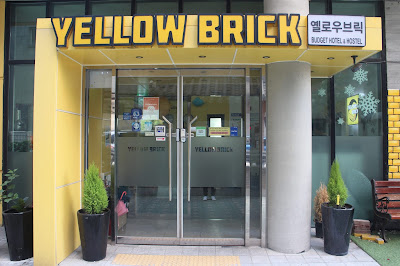 |
| The Yellow Brick Hostel |
 |
| The pantry, one of the cozy communal areas of Yellow Brick |
Read our review of the hotel: Waking Up to Good Things at Yellow Brick Hostel Seoul
South Korea Electricity
In South Korea the power sockets are type C and F. Make sure to bring a two-round-pinned adapter so you can charge your devices. Alternatively, Yellow Brick Hostel offers adapter rental at a very reasonable rate.
The standard voltage is 220V and the standard frequency is 60Hz. Many of today's devices such as mobile phone chargers will automatically switch to the network voltage and will work fine. However, always check your device's voltage before traveling as connecting it to the wrong voltage might damage your device.
Getting to Seoul from Incheon
From Incheon International Airport, there are several transport options to get to downtown Seoul.
The usual option is the Airport Railroad Express, also know as AREX. There are express trains that go non-stop to Seoul Station and all-stop trains that stop at all twelve stations in between. The express train takes 43 minutes from Incheon to Seoul while the all-stop train takes 58 minutes. The express train costs KRW8,000 for adults and KRW6,900 for children. The all-stop train to Seoul costs KRW4,150.
The next option is the Airport Limousine Bus. It runs from the airport to most of the districts in Seoul. The buses are divided into express limousine buses that go to major hotels in the city, Korean Air Lines (KAL) limousine buses that go to major hotels and transit hubs, and regular limousine buses that go to different parts of Seoul. The bus services cost between KRW10,000-15,000 and travel time will take between 60-90 minutes.
Last option will be the taxi. Taxis are run by meters and paid by the distance after the flag down rate. In case of taking a taxi from the airport, expect fares between KRW45,000-75,000 plus a toll of KRW6,600 for Airport Expressway. Travel time takes around 60 minutes.
Since we arrived early in the morning and we're not sure the hotel can accommodate our early check-in request, we decided to take the limousine bus to be able to catch some sleep and arrive later in Seoul. We took Bus 6011 to Changdeokgung Palace which is just a few minutes walk to the hotel.
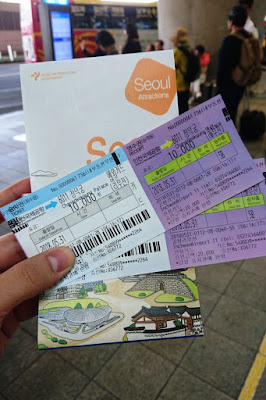 |
| Airport Limousine Bus Tickets |
Getting around Seoul is easy with its very well connected and extensive public transportation network. Transportation options include subway, bus, and taxi.
Seoul's subway is the second most used metro transportation system in the world. It is a reliable way to get to most places in the city. There are currently 21 lines - nine numbered metro lines, the express airport line, and named regional lines that serve the greater metropolitan region and beyond. All these lines are distinguished by different colors. Download the Subway Korea app to navigate your way through Seoul's maze of train lines.
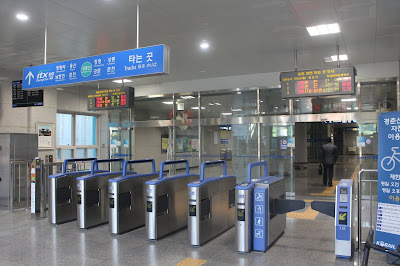 |
| Station of Gyeongchun regional line |
Taxis are available 24 hours and can be hailed along any relatively major Seoul street. The taxis are grouped into four classes. The regular taxis which come in either orange or silver colors are generally the cheapest and can be seen anywhere in Seoul. The deluxe taxis in black colors are more expensive and promises more comfort. The large taxis with Jumbo Taxi signs on the side have the same fare as deluxe taxis but can accommodate 4-6 persons. Then there are international taxis where drivers can speak one or more foreign languages fluently. International taxis can be reserved via phone or the website.
While in Seoul, we mostly used the subway to go to most of our destinations. It is an easy, safe, and efficient way to move around the city. The system, from signage to announcements, use both Korean and English making it easy to use for foreigners.
Things to Do
1. Experience Palatial Grandeur at the Five Grand Palaces
Seoul is home to five royal palaces from the Joseon Dynasty. These palaces served as not just the living quarters of the royal family but as government offices as well. They are generally made up of several buildings with a throne hall, council hall, living quarters, and gardens. Each building is made of wood with tiled roofs and dancheong-painted pillars and rafters illustrating the authority of the king.
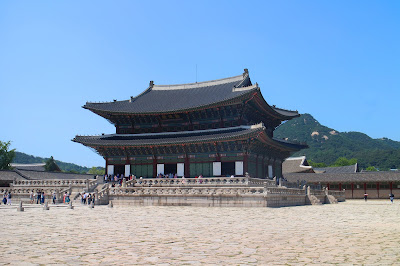 |
| Gyeongbukgung Palace, the largest of all five grand palaces |
Read: Experiencing Palatial Grandeur Inside Gyeongbokgung Palace
2. Wear a Hanbok
The hanbok is the traditional clothing of Korea. It is characterized by vibrant colors and elegant style. It has been around since the 3rd century BCE but because of its functionality, its basic structure and design features have remained pretty much the same. It is usually seen in Korean historical dramas and worn during special occasions.
Instead of just admiring it from pictures and TV shows, why not try out the traditional clothing for a more complete Korean culture experience? Wearing one can also get you free admission to all the grand palaces of Seoul.
 |
| Wear a hanbok for a complete experience |
Read: Yangban For A Day: Suiting Up A Hanbok
3. Hike Up Mt. Namsan
South Korea is blessed with a mountainous topography - around 70% of its landscape is made up of mountains. So it is not surprising that Seoul is bordered by eight mountains.
One of the most popular hiking trails is Mt. Namsan located at south central Seoul. Although not as high as the other mountains of Seoul, it is still very popular because of its easy hiking trails and scenic panoramic views of the city.
Enjoy a short hike up Mt. Namsan and see the N Seoul Tower located at its peak.
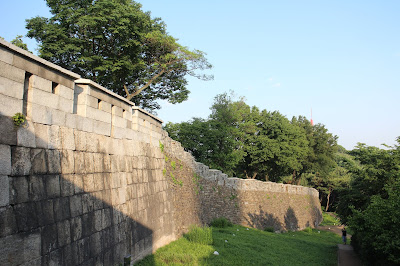 |
| Hike up Mt. Namsan and see the Hanyangdoseong or Seoul City Wall |
4. Eat Chimaek
When in Seoul, one must always find the opportunity to go out for chimaek. Chimaek is short for chicken and maekju, Korean for beer. It has grown into a massive industry with chimaek restaurants far outnumbering any fast food shops in South Korea. It is already considered part of the Korean dining culture.
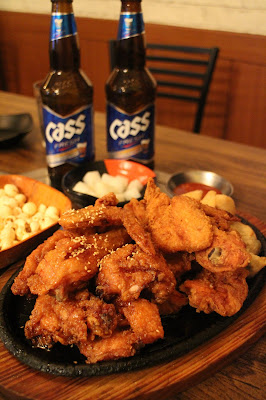 |
| Perfect combination of chicken and maekju |
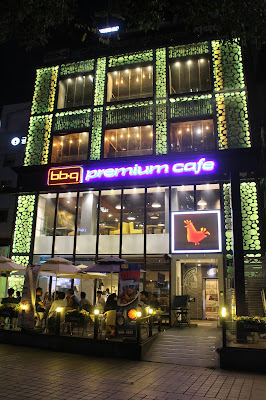 |
| Goblin's Chimaek Store |
Cheonggyecheon is a 10.9 kilometer modern public recreation space in downtown Seoul. It was originally a natural stream that was covered up with concrete to give way to an elevated highway. Then in 2003, a massive restoration of the stream was undertaken to re-introduce nature and promote an eco-friendly urban setting. Upon completion, it was lauded as major success in urban renewal and beautification.
Take a leisurely stroll along this beautiful and unexpectedly quiet oasis in the heart of the Seoul. Explore its 22 bridges and learn stories from the attractions along its length.
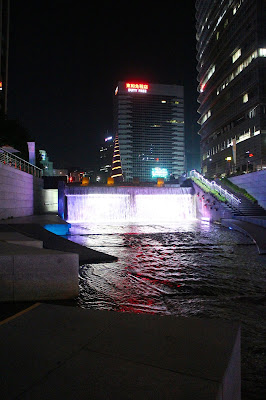 |
| The starting point of Cheonggyecheon Stream |
Seoul is definitely a beauty junkie paradise, thanks to an entire neighborhood dedicated to beauty and skin care shops. You will be surprised that hundreds of cosmetics stores line up the streets of Myeongdong. Big names such as Nature Republic, Missha, The Face Shop, Laneige, Tony Moly, Etude House, Innisfree, and Skin Food, even have multiple stores on different corners of the shopping district.
Get lost and spend hours hauling products in Myeongdong. Check out some shops and you might even get free product samples.
 |
| Shop til you drop in Myeongdong |
Street food is probably the easiest and cheapest way to experience the culinary culture of South Korea. Walking through Seoul's streets and back alleys, you'll sure to find food carts and stalls where you can treat yourself to various local delicacies.
Head over to Myeongdong, Gwangjang, Namdaemun, or Insadong to binge on delicious and affordable street food.
 |
| Yummy Tteokbokki and Chicken |
Insadong is a must-visit neighborhood in Seoul located between the grand palaces. Its streets are filled with art galleries, tea houses, Korean craft stores, souvenir shops, restaurants, food carts, and even cosmetics stores.
Wander through the streets of Insadong and you will find some great little treasures and gifts to take home.
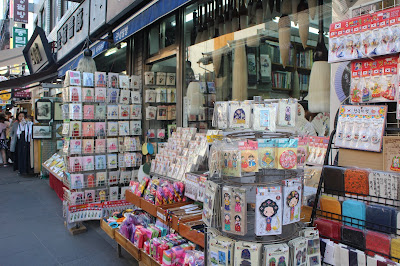 |
| Souvenir shops are common sights in Insadong |
 |
| Check out some handcrafts to take back home |
One of the best things about Seoul is that you are likely to find a convenience store in every other street corner. These all-in-one convenience stores, led by CU, GS25, and 7-Eleven, offer a variety of goodies. You can't leave Korea without even trying some of these products.
Good to try items include the Dosirak or Korean Lunch Boxes, Samgak Gimbap or Triangular Rice Balls, Hot Bar Food Items, Binggrae Banana Milk, Ryan Cheesecake, Chips, and Drink Packets.
 |
| Tasty, filling, and affordable Dosirak from CU |
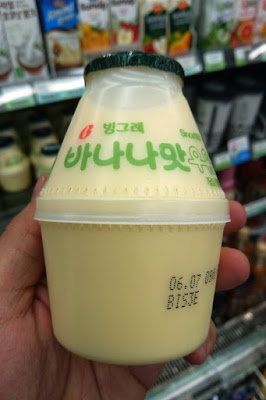 |
| Binggrae Banana Milk |
10. Visit Popular Filming Locations of K-Dramas
Take your vacation to the next level and relive your favorite Korean drama shows. How? Visit their beautiful and iconic filming locations. Usual recommendations are Nami Island which was seen in Winter Sonata; N Seoul Tower which was featured in My Love from the Star and Boys Over Flower; and Petite France which was a backdrop for My Love from the Star and Secret Garden.
 |
| Nami Island statue of Bae Yong Joon and Choi Ji Woo of Winter Sonata fame |
 |
| Petite France, a French-style theme park, seen in My Love from the Star |
 |
| Garden of Morning Calm |
 |
| Dongdaemun Design Plaza |
 |
| Gyeongbukgung Palace |
 |
| Gwanghamun Gate |
 |
| Goblin memorabilia displayed in BBQ Premium Cafe |
Read about our visit to some of the popular K-Drama filming locations:
Experiencing Palatial Grandeur Inside Gyeongbokgung Palace
Seeing from Above the N Seoul Tower
Beyond Seoul: Exploring Nami Island
Beyond Seoul: Being Inspired at Petite France
Beyond Seoul: Visiting the Garden of Morning Calm
Where to Eat
There are literally thousands of food shops and restaurants in Seoul. For authentic local dishes, there are Korean restaurants found in every street and alley of the city. Ask the locals or do some research in the area you're staying in. You will most likely find a really good restaurant. For international food, head over to Itaewon where Seoul's largest expatriate community is located.
Budget
Usual packages offered by travel agencies are priced around PHP30,000 excluding Philippine Travel Tax, tips, and shopping expenses. Here's our budget guide to share how we were able to travel to Seoul in 6 days for less than PHP25,000 all in: Seoul: A Budget Travel Guide for Juans
This guide is designed based on our experience and we hope this is of use to Juans who plan to travel for the first time to Seoul.
Are you planning a trip to Seoul? Leave your questions below and we'll try to help out. If you find this useful, please share on social media. Thanks!

No comments:
Post a Comment